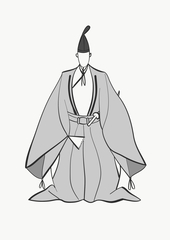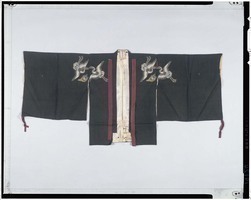Hitatare
ひたたれ 直垂
A hitatare is a broad-sleeved (ōsode 大袖) noh costume. It is a lined hemp suit with matching designs on its broad-sleeved jacket and pleated trousers and is worn by roles of daimyō and samurai officials in noh and kyogen. The pleated trousers (hakama) may be either long or short.
Noh Kyogen
Roles and Draping
Hitatare suits consist of a jacket and trousers with matching designs. Samurai officials wear hitatare over noshime 熨斗目, presenting an imposing figure in formal long trailing trousers (nagabakama 長袴). The kyogen actor taking the role of Sambasō in the Shikisanban 式三番 ritual (also known as Okina 翁) wears a hitatare with ankle-length hanbakama, since his performance includes high jumps, stamps, and vigorous movement.

Tailoring and Textile Features
The upper garment of the hitatare has open cuffs, double-width sleeves and short front panels that are tucked into the trousers. Flat tying cords are attached at the chest and tucked in under the belt. Cord tassels also dangle from the outer corner of the sleeves. The seams at the center back and sleeves have reinforcement cloth strips where one would expect a family crest. When worn with non-matching trousers, this upper garment is known as a kakehitatare. The pleated trousers come in two styles: the formal long trailing trousers nagabakama and ankle-length hanbakama. Reinforcement cloth strips are placed mid-thigh, where the front and back trouser panels join. the waistband and ties are made from a separate, white, cloth.
The plain weave hemp garments are patterned with surface designs typically done with paste-resist, either applied through a stencil (katazome) or hand drawn using a funnel (tsutsugaki). Extra colors are often brushed on or applied with a stamp.
Designs and Colors
Designs range from small repeat patterns to bold overall divisions of colors and large painterly designs that use the combined suit as a huge canvas. Colors include indigo, brown, green, and black. The Sambasō hitatare features long-life imagery of cranes, tortoises and pine twigs, motifs that are incorporated into designs on hitatare used for other roles as well.

Hitatare upper with cranes and tortoises on a dark green hemp ground. 18th century. Tokyo National Museum
http://webarchives.tnm.jp/imgsearch/show/C0059498
Contributor
Monica Bethe